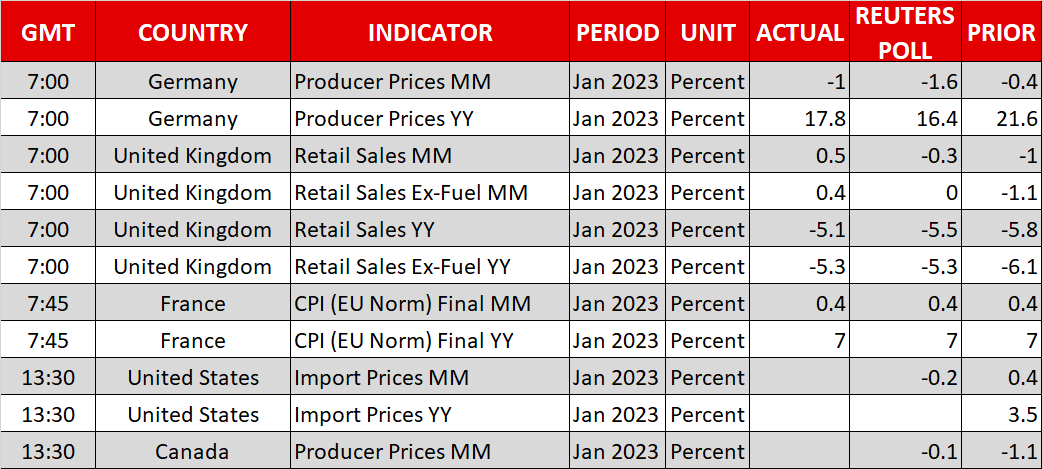Data and Fed Officials Take the Dollar Higher
- US producer prices accelerate, initial jobless claims slide
- Fed’s Mester and Bullard appear in their hawkish suits
- Dollar extends gain, Wall Street slides as Fed hike bets grow

Accelerating PPIs and sliding jobless claims add to Fed hike bets
The US dollar continued flexing its muscles, outperforming almost all the other major currencies yesterday and accelerating its advance today.
What encouraged dollar traders to add to their long positions may have been another round of data releases supporting more hikes by the Fed, and hawkish remarks by a couple of policymakers.
Getting the ball rolling with the data, both the headline and core PPI rates for January declined by less than expected, but what likely attracted the most attention was the strong rebound in the monthly rate from -0.2% to 0.7%, nearly double the forecast of 0.4%. It is also worth noting that December’s monthly rate was revised up from -0.5% to -0.2%.
Accelerating producer prices could translate into higher consumer prices in the months to come and thus, combined with the unexpected slide in the initial jobless claims for last week, the data comes to add more credence to the view that the Fed may eventually need to take interest rates higher than previously expected and that no cuts would be needed this year after all.
Fed’s Mester and Bullard argue for higher interest rates
Fed speakers seem to agree with the market’s interpretation of the data. Yesterday, Cleveland President Loretta Mester seemed concerned about too high inflation and noted that interest rates should have been raised more at the last meeting, with St. Louis President James Bullard agreeing in a separate speech that the Fed should have been more aggressive with its recent decision. Neither Bullard nor Mester are voting members this year, but the market has already raised around a 10% probability for a 50bps hike at the upcoming gathering, with the remaining 90% pointing to 25bps.
Bullard also said that he sees a terminal rate within the 5.25%-5.50% range as appropriate, suggesting that, like Kashkari, his dot may have been among the ones above the median in December. Should more members become vocal about a higher peak in interest rates, investors could see the median projection for 2023 being revised up in March. Today, Richmond President Thomas Barkin and Governor Bowman will step onto the rostrum and investors may be eager to listen to their views.
Currently investors are pricing in a terminal rate of about5.30%. So, more data or Fed comments adding to that view might keep the dollar under buying interest. However, although the upside risks surrounding the greenback’s short-term performance continue to increase, it is too early to envision a full-scale bullish reversal as ahead of the March FOMC gathering, investors will have to evaluate employment and inflation data for the month of February.
Fed hike bets hurt Wall Street
Each of Wall Street’s main indices finished Thursday’s session down more than 1%, with the more rate sensitive Nasdaq sliding nearly 2%. It seems that data pointing to higher inflation have eventually dented investors’ risk appetite, even if numbers relating to economic growth are pointing to a potential soft landing.
This is adding credence to the view that, despite the optimism surrounding China’s reopening and the evidence that major economies like the Eurozone may have avoided a recession, it is hard to envision indices headed to new record highs. Higher interest rates mean higher borrowing costs for companies, as well as lower present values for firms that are valued by discounting expected cash flows.
With the S&P 500 being rejected from near the important resistance zone of 4,155, further declines cannot be ruled out. However, positive surprises in upcoming growth-related data could revive some excitement and thereby result in another rebound. Ergo, the bigger picture of equity indices remains neutral. For the outlook of the S&P 500 to darken, a break back below 3,900 may be needed. The chances for such a dip could increase should next week’s preliminary PMIs for February disappoint.



